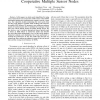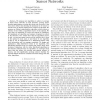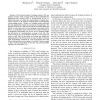INFOCOM
2007
IEEE
14 years 6 months ago
2007
IEEE
— High-speed backbones are regularly affected by various kinds of network anomalies, ranging from malicious attacks to harmless large data transfers. Different types of anomalies...
INFOCOM
2007
IEEE
14 years 6 months ago
2007
IEEE
—Unstructured networks (like ad-hoc or peer-to-peer networks) are networks without centralized control of their operation. Users make local decisions regarding whether to follow ...
INFOCOM
2007
IEEE
14 years 6 months ago
2007
IEEE
— In this paper we propose and analyze a generalized multiple-tree-based overlay architecture for peer-to-peer live streaming that employs multipath transmission and forward erro...
INFOCOM
2007
IEEE
14 years 6 months ago
2007
IEEE
—In an adversarial environment, various kinds of security attacks become possible if malicious nodes could claim fake locations that are different from where they are physically ...
INFOCOM
2007
IEEE
14 years 6 months ago
2007
IEEE
— In this paper, we study search algorithms for using a set of autonomous and cooperative mobile sensor nodes (MSN) with limited sensing and communication ranges to search a larg...
INFOCOM
2007
IEEE
14 years 6 months ago
2007
IEEE
— Wireless reprogramming of a sensor network is useful for uploading new code or for changing the functionality of existing code. Through the process, a node should remain recept...
INFOCOM
2007
IEEE
14 years 6 months ago
2007
IEEE
— Despite the increasing number of WiFi-based Long Distance (WiLD) network deployments, there is a lack of understanding of how WiLD networks perform in practice. In this paper, ...
INFOCOM
2007
IEEE
14 years 6 months ago
2007
IEEE
INFOCOM
2007
IEEE
14 years 6 months ago
2007
IEEE
— We propose new algorithms to achieve k-coverage in dense sensor networks. In such networks, covering sensor locations approximates covering the whole area. However, it has been...
INFOCOM
2007
IEEE
14 years 6 months ago
2007
IEEE
— The broadcast nature of existing wireless LANs can produce excessive radio coverage which is often undesirable for applications like wireless IPTV or location-based service. To...



